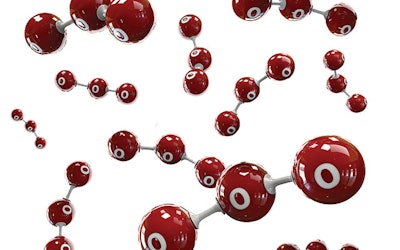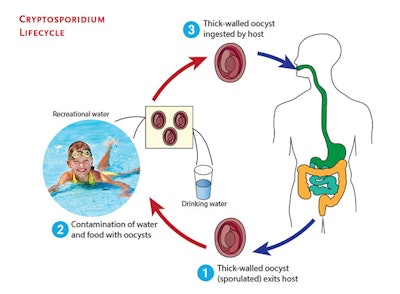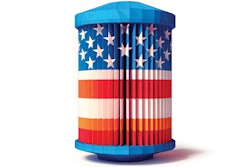
With the spa industry's growing emphasis on the health benefits of hot tubs and swim spas, minimizing the chances of health concerns is vital. From Legionella to chloramines, spa manufacturers and retailers must constantly be on the offensive against threats to user health.
Sanitizing systems are obviously at the heart of the issue. The operative word is "systems" — just relying on chlorine or bromine disinfectants is not enough.
A 2005 article in "Water Conditioning and Purification" estimated that up to 85 percent of the chlorine used in a spa without any other water sanitation system is consumed in oxidation processes, just 2.5 percent is used for disinfection, another 2.5 percent maintains residual levels in the water and 10 percent is destroyed by the hot water in the tub. The figures for bromine on its own are also sobering — 7.5 percent provides disinfection, 2.5 percent residual, 10 percent is destroyed by the hot water and 80 percent is tied up in oxidation.
To get greater performance from chlorine and bromine, spa owners must introduce a powerful oxidizing agent, most notably ozone, which is why 50 to 75 percent of the spas built today include an ozonation system and injector. However, it is not enough to just introduce ozone to the water. The ozone must be thoroughly dissolved to do its job.
Challenging Soup
A spa's tremendous oxidation demand comes from the rich soup of compounds in the water. In a recent issue of AQUA, Robert Lowry notes that the average person sweats 3 pints per hour at 102 degrees Fahrenheit. Between urine and sweat, there are 186 substances, he adds, including urea and creatinine, which combine with chlorine to form chloramines or with bromine to create bromamines. In fact, the reaction of perspiration and waste with chlorine sanitizers is the largest contributor to chloramine formation in spas and pools, according to an APSP Recreational Water Quality Committee report.
RELATED: Spa Soup — Why We Dump Spa Water
Heavier than air, chloramines accumulate near the water surface; in spas, they can be delivered to users' lungs in steam and aerosols. Inhaling them can cause respiratory problems such as coughing and irritation. Chloramines can also react with iodide to produce n-nitrosodimethylamine, a possible human carcinogen. Chlorine in combination with organic acids can create a range of disinfection byproducts such as trihalomethanes, haloacetic acids and a wide range of other compounds with serious health effects.
Scum and Biofilm
On top of sweat and urine, the average bather brings 100 million bacteria into the water. In addition, the average adult uses nine personal care products per day — representing a total of 126 unique ingredients — according to "Skin Deep," a 2004 study by the Environmental Working Group. Then there are sloughed-off skin cells, hair and oils.
In spa water, those personal care products and personal cast-offs combine to form scum, scale and biofilms that can shield pathogens from disinfectants, setting the stage for inefficient sanitizing or even failure.
Bathers and swimmers are also increasingly bringing cryptosporidium with them. The Centers for Disease Control reported 32 outbreaks of crypto in swimming pools and water parks in 2016, twice the number reported in 2014. Crypto, which can cause severe diarrhea, can survive for 10 days in chlorinated water. However, ozone's aggressive oxidation is shown to be highly effective at killing cryptosporidium.
RELATED: Attack the Spa's Biofilm Sanctuaries

Legionella Threat
When it comes to sanitization failure in spas, the most alarming threat is Legionella. The causal agent of Legionnaire's Disease — which struck more than 200 attendees at a 1976 American Legion convention with a mysterious pneumonia, killing 34 of them — causes 8,000 to 18,000 hospitalizations each year in the U.S., according to the CDC. It is especially dangerous to people over the age of 50, smokers, people with lung disease and patients with compromised immune systems.
Few places make better breeding grounds for Legionella than hot tubs. The pathogen thrives in water temperatures between 68 and 122 degrees Fahrenheit and escapes disinfection by colonizing beneath protective scale and biofilms. It was little surprise that the source of an outbreak of Legionnaire's Disease in 2015 that killed three visitors to a British home improvement center was a poorly maintained hot tub near the checkout registers.
Adding detergent to water can disperse biofouling. Chlorine or bromine shock treatment can reduce scale and biofilm through oxidation. But ozone is a more effective oxidizer, blazing the way for the disinfection effects of Cl or Br.
Proper Ozonation
Some spa manufacturers and service technicians say they enjoy "the sweet smell of ozone in the tub" — they say it is a signal that the system is working. In truth, what they are smelling is ozone escaping the system, a clear sign that the system is not functioning optimally. That can damage users' lungs as well as hot tub covers and other exposed materials. An effective ozonation system won't smell like ozone at all, because the ozone is dissolved in the spa water, where it can do its work.
The most efficient, effective way to inject ozone into spa water is through a Venturi injector, which uses the flow of water through a specially constructed pair of cones to draw ozone into the liquid and create an ozone/water slurry. To maximize the draw of gas into the flow and ensure thorough mixing, both cones and the orifice of the Venturi injector must be exactingly engineered and constructed.
RELATED: Understanding Advanced Oxidation Process
The same care should go into the next step of the process, the Flash Reactor, which shears ozone bubbles and improves the incorporation of the gas into the water without the need for applied pressure or other system modifications. Releasing the ozonated water into the tub through mixing nozzles completes the process, re-shearing remaining bubbles and ensuring that the maximum amount of ozone is dissolved in the water as it enters the tub.
Multiple Benefits
Floating off into the air, ozone can be a nuisance, a threat and a waste. But mixed thoroughly into spa water, ozone is a powerful oxidizer of scale, scum and biofilm. It prevents the formation of chloramines and bromamines by breaking up nitrogenous compounds, oils and organic materials. And ozone can even regenerate spent bromine ions into hypobromous acid, renewing the water's supply of the killing form of the disinfectant.
In short, the key to an effective sanitizing system is a multistage approach, and even that definition has two stages. First, ensure that disinfection is preceded by ozonation. Second, make sure that ozone is reliably produced and effectively mixed to achieve its full disinfection potential, helping spa owners enjoy the health benefits of their investment — without the health risks.
Jim Lauria is vice president of sales and marketing for Mazzei Injector Company, a fluid design company that manufactures mixing and contacting systems. He holds a bachelor of chemical engineering degree from Manhattan College and has more than 20 years of global water treatment experience in the agricultural, municipal, industrial and commercial markets.







































